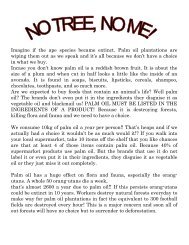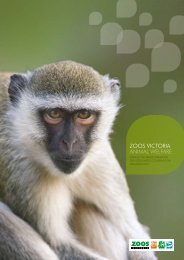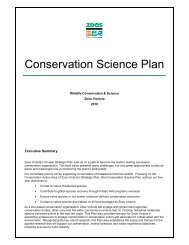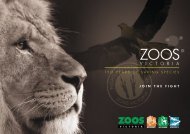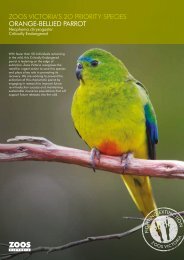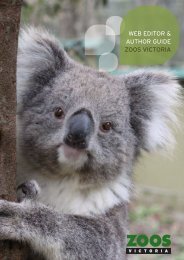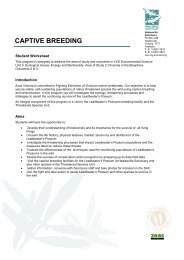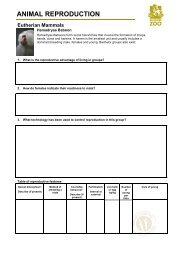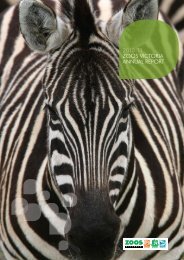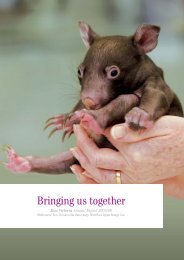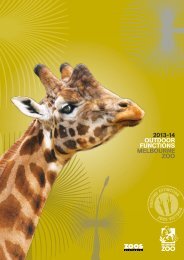Student workbook
Student workbook
Student workbook
- No tags were found...
You also want an ePaper? Increase the reach of your titles
YUMPU automatically turns print PDFs into web optimized ePapers that Google loves.
VCE Biology Unit 2; Area of Study 1: Area of Study 2DYNAMIC ECOSYSTEMSAN ALMOST NATURAL COMMUNITYAdaptations of Organisms; Dynamic Ecosystems<strong>Student</strong> Workbook
Dynamic Ecosystems — <strong>Student</strong> WorkbookLearning Experiences is a partnership with
Dynamic Ecosystems — <strong>Student</strong> WorkbookIntroductionThis program is designed to meet the requirements of the school-assessed coursework (SAC) component for Outcome 2,Field Investigation. It addresses the key knowledge and skills related to VCE Biology Unit 2 , Organisms and theirEnvironment , Area of Study 2 with particular reference to relationships of organisms in their environment.Aims• to investigate and describe a natural community of organisms;• to recognise the boundaries between different communities;• to identify and describe the relationships between organisms and their surroundings.Program instructionsThe program is undertaken in 16 ha. of bushland, known as the Coranderrk Nature Trail, that adjoins the Sanctuary. Threedistinct communities are present in this area of bushland - dry ridge top, flood plain and riparian or creek side. Theopportunity to explore and compare the three communities is achieved through the following activities: identification andrecording of animal evidence, use of taxonomic keys to classify plants, completing a transect profile and quadrat in eachcommunity.<strong>Student</strong>s will work collaboratively in small groups and will be assigned one of the three communities. This activity takes 1.5hours to complete.Analysis of the data collected can occur following the activity and a detailed conclusion can be formed.This symbol denotes you have a task to perform.Topographic mapNCoranderrk Fence LineHealesville SanctuaryScale-20 0 20 40metresBadger CreekDirection of flow
Dynamic Ecosystems — <strong>Student</strong> WorkbookBeaufort Wind Scale Site conditions - weatherDay ................... Date ...... / ...... / ...... Time ................TemperaturehotwarmcoolcoldforcePrecipitation• Raining?YesIf yes, is it:heavy?light?speed(km/hr)Noconstant?intermittent?windCloud cover............. % cover(0 -100%)WindForce ..........definition0 0—2 Calm Smoke rises vertically1 3—5 Light air Smoke slowly drifts2 6—11 Light breeze Wind felt; leaves gently rustle3 12—18 Gentle breeze Leaves in continuousmovement; flags flap4 19—26 Moderate breeze Dust and paper blown about; smallbranches in motion5 27—34 Fresh breeze Small trees in leaf sway; crestedwavelets form on inland waters6 35—43 Strong breeze Branches in motion, whispering intelephone wires7 44—53 Moderate gale Whole trees swayAt which point should wenot be out in the bush?.................................8 54—64 Fresh gale Twigs and small branches broken offtrees; progress impeded9 65-77 Strong gale Large branches broken off; slightstructural damage to houses10 78—90 Whole gale Trees uprooted; roof damage11 91—104 Storm Rarely experienced inland
Dynamic Ecosystems — <strong>Student</strong> WorkbookEvidence of consumersAs you walk around the trail you should spend some time just looking at the area you are walking through and developinga 'feel’ for the natural bush. When absorbed in fact-finding activities, it is easy to overlook the natural wonders aroundyou.• Using the table below, record any evidence of vertebrate and invertebrate consumers. Such evidence mayinclude: spiders' webs, yabby holes, bore holes in trees, droppings, scratchings, nests, sightings of the animalsthemselves. You may like to make brief notes and/or include diagrams.Key to recording informationLocation FP floodplain Diet O omnivoreR riparian C carnivoreDR dry ridge H herbivoreClassification I invertebrate B birdR reptile A frog (Amphibian)M mammal F fishType of EvidenceLocationFP, R, DRClassificationI, R, M, B, A, FDietO, H, C
Dynamic Ecosystems — <strong>Student</strong> WorkbookAcacias EucalyptsCandlebark(E. rubida)bipinnatefoliageAcacia0.5mofroughbark onbuttover2m ofroughbarkonbuttManna Gum(E. viminalis)AJCedar Wattle(Acacia elata)AJABarksmooth,white tocreamsheds inribbonsor flakesSilver Wattle(Acacia dealbata)Barkinterlacedfinely,not shedEucalpytPeppermint (E. radiata)JBarkthick longfibredstrands overtrunk &branchesAEucalyptus (Gum Trees)Acacia (Wattle Trees)JA. Adult leavesJ. Juvenile leavesRed Stringybark(E. macrorhyncha)Eucalypts first appeared in the fossil record some 34 million years agoand since that time they have diversified to become the mostdominant plant group in Australia. Their sclerphyllous adaptationshave suited the gradual drying out of the Australian landscape andgiven them an adaptive advantage over their broad leaf competitors.The Manna Gum in particular is the most abundant eucalypt insouth-eastern Australia.glands evenly spacedphyllodespresentBlackwood(A. melanoxylon)Hop Wattle(A. stricta)While first appearing somewhat later in the fossil record (25million years ago) than eucalypts, acacias have neverthelessdiversified to more species than any other plant genus. Whileoften taking the role of the sub-canopy in south-easternAustralia, they did begin to replace eucalypts throughout centralAustralia when Australia was in the grip of its driest period10,000 years ago.• Kind permission of Leon Costermans, Native Trees & Shrubs of South-eastern Australia
Dynamic Ecosystems — <strong>Student</strong> WorkbookMature ferns and allied plants reproduce by spores borne on the underside of fronds (not by flowers and hence do notproduce fruits or seeds).1. (a) Ferns with a solid trunk and fronds over 1 metre longemerging from the top of trunk .................... go to 2Ferns(b) Ferns with a small trunk and fronds under 1 metre .................... Fishbone Water-fernBlechnum nudum(c) Ferns without a distinct trunk .................... go to 32. (a) Base of the fronds smooth .................... Soft Tree-fernDicksonia antarctica(b) Base of the fronds rough, with scales .................... Rough Tree-fern3. (a) Fronds dark green, glossy and 30 to 100 cm's in length.Cyathea australisDark red/brown hairs towards the base of stem .................... Austral BrackenPteridium esculentum(b) Fronds light green, soft to touch but otherwise similar toAustral Bracken .................... False BrackenCalochlaena dubiaSpeciesField CharacteristicsField characteristicsManna GumEucalyptus viminalisSilver WattleAcacia dealbataPrickly Currant BushCoprosma quadrifidaHazel PomaderrisPomaderris asperaSweet BursariaBursaria spinosa
Dynamic Ecosystems — <strong>Student</strong> WorkbookTo complete a profile of a vegetation community the following information and tasks need to be obtained and completedrespectively.Community profileAbiotic factorsThere are numerous factors involved in shaping the structure and composition of a community of plants and animals.These include both abiotic (non-living) and biotic (living) factors. The abiotic factors about which you will need to obtaindata are: soil structure, light intensity, temperature, wind strength and humidity.The recording of such information provides a 'picture' of the non living factors present which are having a directinfluence on the plants growing in a particular area. This information can then be used to compare different plantcommunities.Line transect profile1. Lay a 10 metre string out to define your profile length.2. Make a rough sketch on the horizontal axis to show the lay of the land.3. Move along the string in 1 metre intervals and record the dominant vegetation that occurs there using the keyand symbols provided.Canopy (trees>20m)Sub-canopy (trees
Dynamic Ecosystems — <strong>Student</strong> WorkbookQuadrat data collection1. Mark out your 10m x 10m quadrat with the string provided.Community Profile2. Assign each member of your group a section of the quadrat data sheet to complete e.g. trees.3. Move through the quadrat and record each species of trees and shrubs and saplings, that occurs there and inwhat numbers in the relevant section of the table provided.Cover ClassThis is calculated by estimating what percentage of your area is covered by a particular species and converting it to acover class using the table below: The shaded area produced by a particular species when the sun is directly overheadis a good indication of what percentage of the area is covered.Cover classPercentage5 75% - 100%4 50% - 75%3 25% - 50%2 5% - 25%1 1% - 5%+ less than 1%Following the directions provided ,fill in the appropriate pages for the vegetation community that your group has been assignedto study.• Riparian pp. 11 & 12,• Floodplain pp. 13 & 14,• Ridge-top pp. 15 & 16
Dynamic Ecosystems — <strong>Student</strong> WorkbookAbiotic factorsSoil (smell, feel, moisture, content)RIPARIAN COMMUNITYTemperatureHumidityLightWindSpecies key1. Manna Gum2. Hazel Pomaderris3. Rough tree Fern4. Prickly Currant Bush5. Austral Mulberry6. Fishbone Water-fern7. Grasses and grass-likeplants8. Austral Bracken9. Forest Hounds-tongue10. Other484440Transect profileHeight of vegetation3632282420161284metres 0 1 2 3 4 5 6 7 8 9 10Length of profile
Dynamic Ecosystems — <strong>Student</strong> WorkbookRiparian Quadrat Data Sheettreesshrubs &saplingsSpeciesTotal No.DensityArea100m²100m²100m²100m²100m²100m²100m²100m²100m²Density(per sq. m)CoverClassGrasses and HerbsLeaf LitterSoilCover class Percentage5 75% - 100%4 50% - 75%3 25% - 50%2 5% - 25%1 1% - 5%+ less than 1%Hazel Pomaderris (Pomaderris aspera)Marker SpeciesDescribe the upper surface of the leaf.Describe the underside of the leaf.What is the angle of the leaf inrelation to the sun?Draw an outline of the leafDoes the leaf contain oils?
Dynamic Ecosystems — <strong>Student</strong> WorkbookFLOODPLAIN COMMUNITYAbiotic factorsSoil (smell, feel, moisture, content)TemperatureHumidityLightWindSpecies key1. Manna Gum2. Silver Wattle3. Blackwood4. Burgan5. Sweet Bursaria6. Prickly Currant Bush7. Grasses and grass-like plants8. Other48444036Transect profileHeight of vegetation32282420161284metres 0 1 2 3 4 5 6 7 8 9 10Length of profile
Dynamic Ecosystems — <strong>Student</strong> WorkbookFloodplain Quadrat Data Sheettreesshrubs &saplingsSpeciesGrasses and HerbsTotal No.DensityArea100m²100m²100m²100m²100m²100m²100m²100m²100m²Density(per sq. m)CoverClassLeaf LitterSoilCover class Percentage5 75% - 100%4 50% - 75%3 25% - 50%2 5% - 25%1 1% - 5%+ less than 1%Prickly Currant Bush (Coprosma quadrifida)Marker SpeciesDescribe the upper surface of the leaf.Describe the underside of the leaf.What is the angle of the leaf inrelation to the sun?Draw an outline of the leafDoes the leaf contain oils?
Dynamic Ecosystems — <strong>Student</strong> WorkbookRIDGE-TOP COMMUNITYAbiotic factorsSoil (smell, feel, moisture, content)TemperatureHumidityLightWindSpecies key1. Narrow-leaved Peppermint2. Red Stringybark3. Candle Bark4. Burgan6. Common Cassinia7. Grasses and grass-like plants8. Other5. Prickly Currant Bush242220Transect profileHeight of vegetation18161412108642metres 0 1 2 3 4 5 6 7 8 9 10Length of profile
Dynamic Ecosystems — <strong>Student</strong> WorkbookRidge-top Quadrat Data Sheettreesshrubs &saplingsSpeciesGrasses and HerbsTotal No.DensityArea100m²100m²100m²100m²100m²100m²100m²100m²100m²Density(per sq. m)CoverClassLeaf LitterSoilCover class Percentage5 75% - 100%4 50% - 75%3 25% - 50%2 5% - 25%1 1% - 5%+ less than 1%Marker SpeciesNarrow-leaved Peppermint (Eucalyptus radiata)Describe the upper surface of the leaf.Describe the underside of the leaf.What is the angle of the leaf in relation to the sun?Draw an outline of the leafDoes the leaf contain oils?
Dynamic Ecosystems — <strong>Student</strong> WorkbookAnalysis of Quadrat data1. Calculate the density of each species and record in the table provided for the community you studied.Density =Total number of speciesTotal sample area (sq. m)2. Complete the following table listing the plants from dense to least dense for the plant community you studied.Plant species Density (plants/sq. m)Back at school3. Compare the information recorded at Question 2 and your Transect profile and quadrat information for each ofthe three communities.(a)(b)What key differences exist between the plant species of each community?Identify any marker species (a species that is common in one community butabsent from others) for each community. Suggest a reason(s) as to why they mightprefer that particular site?4. Compare the transect profiles of the three different communities. Consider the height of the vegetation, thenumber of vegetation layers and the density of the plants.Which community contains:(a)(b)(c)The tallest trees?The greatest number of vegetation layers?The most dense vegetation?5. Look at the abiotic information collected. Outline the main differences in the physical conditions experienced byeach plant community.Animal evidence6. Why are wombat burrows only evident in the Riparian Zone?7. Why are ants present on the Ridge-top and Floodplain, but not in the Riparian Zone?Consider their diet when responding to this question.ConclusionBy referring to the data you have collected, comment on the nature of the relationships existing between organismsand their environment at the three sites, with particular reference to abiotic factors.
Dynamic Ecosystems — <strong>Student</strong> Workbook____________________________________________________________________________________________________________________________________________________________________________________________________________________________________________________________________________________________________________________________________________________________________________________________________________________________________________________________________________________________________________________________________________________________________________________________________________________________________________________________________________________________________________________________________________________________________________________________________________________________________________________________________________________________________________________________________Notes____________________________________________________________________________________________________________________________________________________________________________________________________________________________________________________________________________________________________________________________________________________________________________________________________________________________________________________________________________________________________________________________________________________________________________________________________________________________________________________________________________________________________________________________________________________________________________________________________________________________________________________________________________________________________________________________________________________________________________________________________________________________________________________________________________
Dynamic Ecosystems — <strong>Student</strong> WorkbookGlossaryabioticRelating to a non living component such astemperatureadaptationa characteristic of an organism that assists its survivalin its environmentaspectthe direction to which a land slopes, e.g., a southerlyaspectbiodiversitythe diversity that exists within ecosystems, plants,animals and genetic materialsbioticRelating to a living organism, either plant or animalbipinnatea pinnate leaf with the leaflets pinnately dividedcarnivorean animal that catches live prey for food; meat eatercommunitya group of organisms, both plants and animals,interacting with each other within a shared habitat orenvironmentconsumeran animal that eats other organisms; can be aherbivore, carnivore, scavenger, or decomposer.Consumers are also classified according to their orderin the food chain - herbivores are primary or first-orderconsumers, carnivores are secondary or higher orderconsumersecosystema community of organisms interacting with one anotherand their physical environmentexudatea substance that oozes out from a pore or smallopeningherbivorean animal that feeds exclusively upon plants; plant eaterindigenousoriginating in and characterizing a particular region orcountrymicrohabitata very small, usually confined and isolated habitat e.g., atree stumpomnivorean animal that feeds upon both plants and animalsphyllodea broadened stem that resembles and performs the samefunctions as that of a leafpinnatedescribes a leaf that is feather-like in appearance, havingleaflets growing from either side of a stemproduceran organism (plant) that manufactures its own food byphotosynthesissclerophyllis the name given to the variety of plants typically found inlow rainfall areas which have tough leaves which help toreduce water lossstomataare minute openings (pores) which occur on all exposedparts of a plant but are most abundant in the epidermislayer of the underside of leavessuccessionthe progressive replacement of one community by anotherin development towards climax vegetationtoxinan organic poison produced by a living or dead organism
Dynamic Ecosystems — <strong>Student</strong> WorkbookMelbourne Zoo Healesville Sanctuary Werribee Open Range ZooPost Office Box 74 Badger Creek Road K RoadParkville Vic 3052 Healesville, Vic 3777 Werribee, Vic 3030Ph: 61 3 9285 9355 Ph: 61 3 5957 2819 Ph: 61 3 9731 9635Fax: 61 3 9285 9340 Fax: 61 3 5957 2873 Fax: 61 3 9731 9644Learning Experiences is a partnership with© These sheets may be reproduced for teaching purposes. Permission to reproduce them for otherpurposes may be obtained from the Learning Experiences at Healesville Sanctuary.




